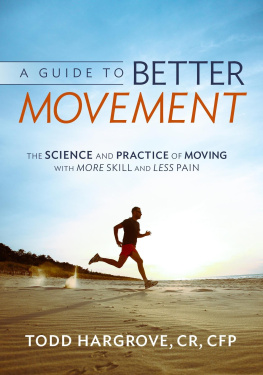Eric Goodman - True to Form: How to Use Foundation Training for Sustained Pain Relief and Everyday Fitness
Here you can read online Eric Goodman - True to Form: How to Use Foundation Training for Sustained Pain Relief and Everyday Fitness full text of the book (entire story) in english for free. Download pdf and epub, get meaning, cover and reviews about this ebook. year: 2016, publisher: Harper Wave, genre: Romance novel. Description of the work, (preface) as well as reviews are available. Best literature library LitArk.com created for fans of good reading and offers a wide selection of genres:
Romance novel
Science fiction
Adventure
Detective
Science
History
Home and family
Prose
Art
Politics
Computer
Non-fiction
Religion
Business
Children
Humor
Choose a favorite category and find really read worthwhile books. Enjoy immersion in the world of imagination, feel the emotions of the characters or learn something new for yourself, make an fascinating discovery.
- Book:True to Form: How to Use Foundation Training for Sustained Pain Relief and Everyday Fitness
- Author:
- Publisher:Harper Wave
- Genre:
- Year:2016
- Rating:5 / 5
- Favourites:Add to favourites
- Your mark:
True to Form: How to Use Foundation Training for Sustained Pain Relief and Everyday Fitness: summary, description and annotation
We offer to read an annotation, description, summary or preface (depends on what the author of the book "True to Form: How to Use Foundation Training for Sustained Pain Relief and Everyday Fitness" wrote himself). If you haven't found the necessary information about the book — write in the comments, we will try to find it.
Radical in its simplicity, Dr. Eric Goodmans visionary approach to mindful movement corrects the complacent adaptations that lead to back and joint pain, and teaches us to harness the bodys natural movement patterns into daily activities to make us fit, healthy, and pain free.
Our sedentary lifestyle has led to an epidemic of chronic pain. By adapting to posture and movement that have us out of balanceincluding sitting all day at a keyboard, tilting our heads forward to look at our phoneswe consistently compromise our joints, give our organs less room to function, and weaken our muscles. How we hold and live in our bodies is fundamental to our overall health, and the good news is that we all hold the key to a healthier body.
Dr. Goodman has spent years studying human physiology and movement. He has trained world-class athletes for better performance, and has healed people of all ages and occupations of lifelong debilitating pain. His theory of self-healing is now available to everyone. His practical program trains the posterior muscle chainshoulders, back, butt, and legsshifting the burden of support away from joints and putting it back where it belongs: into large muscle groups.
Filled with helpful diagrams and sixty color photographs, True to Form shows readers how to successfully integrate these powerful movements into everyday lifefrom playing with the kids to washing dishes to long hours in the officetransforming ordinary physical actions into active and mindful movements that help to eliminate pain, up your game, or simply feel more energetic. True to Form shows you how to move better, breathe better, and get back to using your body the way nature intended.
Eric Goodman: author's other books
Who wrote True to Form: How to Use Foundation Training for Sustained Pain Relief and Everyday Fitness? Find out the surname, the name of the author of the book and a list of all author's works by series.

















